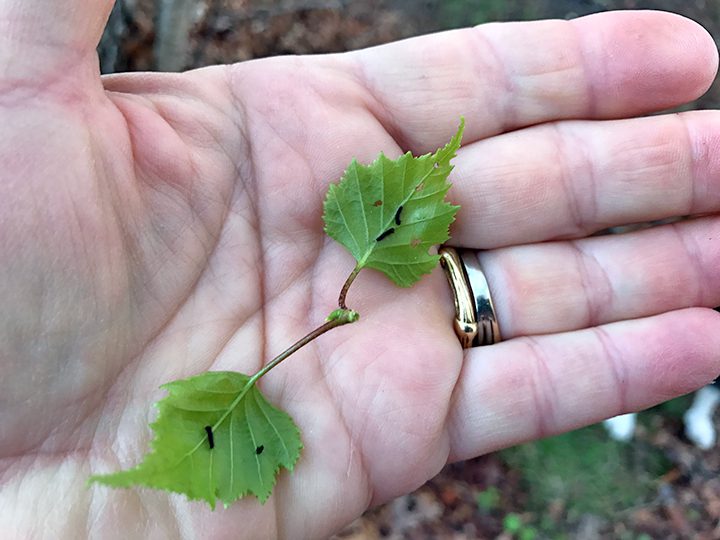Your Trees Are Being Eaten
Your Trees Are Being Eaten
From a distance, all looks well as the grass greens up, the perennials emerge and the trees break dormancy. But a close look at the trees and roses on the Cape will show that there is trouble in paradise…winter moth and gypsy moth larvae have both hatched and are eating away.
Here are just two examples from a birch tree and a beach on my property in Sandwich. The larvae are very small right now, and are taking small bites. But as they grow they will do more damage, so treating with Captain Jacks (active ingredient, spinosad) at this point will help prevent greater loss of leaves. I spray smaller trees and roses with a pump sprayer, and larger trees with a hose-end sprayer. Even if you can’t spray the entire large tree, a great number of larvae will be killed by covering the bottom most branches. Using Trubo spreader sticker in either sprayer is a good idea as it helps the spinosad stick on the leaves.

Here are the tiny gypsy moths at work on a birch leaf. They aren’t noticeable from a distance, but up close you can see them and the small holes they’re making in the leaves.

From a distance this beech tree looks just fine, but when you look closely you’ll find tiny holes that show the presence of the winter moth larvae.
Look closely at your maple trees, crabapples, pears, birch and roses. Treat the plants before or after they bloom so that you won’t spray wet spinosad onto foraging bees. (Dry spinosad isn’t a problem but avoid spraying when bees are on a plant.)

Captain Jack’s Deadbug Brew and Turbo are the products of choice for both winter moth and gypsy moth larvae, and it’s most effective when the larvae are small.
9 Comments
Leave a Comment
Subscribe To Our Newsletter
Sign up for our weekly email about sales and events.

CL – I have been reading about Spinoza and am quite concerned. According to NPIC (National Pesticide Information Center) spinosad is highly toxic to bees. I have a number of fully mature oaks and maples in my yard that have been sprayed with spinosad in the past. However, the spraying season overlaps with the blooming season for many of my large perennials (I.e. Early rhododendron). Yesterday I was happy to see that my flowering plants are covered with bees. I am strongly tempted to cancel the winter moth spraying this year. Do you have a suggestion?
Diane,
It is not true that Spinosad is “highly toxic to bees” – it’s only a problem when it’s WET and applied directly to bees. Once it’s dry it is no problem for bees at all. We always warn people not to spray a blooming plant where bees are foraging. You can wait to spray a blooming plant after it finishes flowering, spray at 5 AM before bees are foraging, or use Bt early in the season. Bt is effective on moth larvae when they are small.
CL – thanks! In the same vein – what is your opinion of Acelepryn?
Active ingredient in Acelepryn is Chlorantraniliprole. This from University Extension websites: “This broad-spectrum anthranilic diamide insecticide interrupts the normal muscle contraction of insects, resulting in death. It adheres to plant surfaces and is most effective when consumed by pests. Therefore, it should only be applied when pest insects are present at damaging levels and are actively consuming plant parts. Chlorantraniliprole may negatively impact beneficial insects and other arthropods and is a potential water contaminant.” Needless to say, it’s the last part of that sentence that worries me.
CL – thanks for such a thorough answer! Sounds like there are only “sorta” good solutions. My yard is currently filled with bees because of my having numerous flowering perennial shrubs – so I’m reluctant to use spinosad. Maybe EARLY morning spraying is the best answer.
Again – thank you
Diane,
I’m not sure what the problem is. Most of the trees that are eaten by the winter moth aren’t flowering when you need to spray them. Crabapples and cherries are the exception but these you can just wait for two weeks and spray them after the flowers are gone so you don’t hit the bees. The blueberries are almost past flowering as well – we sprayed ours three weeks ago before flowering, and will do it again in a week when the flowers are gone. Roses aren’t flowering yet, so spray without concern there. Most of the flowering plants in my yard where the bees forage aren’t anything that winter or gypsy moth eat, so they don’t need to be sprayed at all. So not a huge issue in my book…
Great questions; great answers!
Thanks so much, CL!!
Is it also safe to spray in the early evening – around 6:00 – or are bees still active at this time? We just moved into a house and there are numerous small caterpillars on the back so I’m sure the shrubs & trees are loaded as well. I want to spray them now before they get too large
Usually after 6 PM is fine – and if the trees you are spraying aren’t in bloom the bees won’t be flying around them anyway – bees forage on flowers so if your trees aren’t flowering you’re not likely to hit the bees.